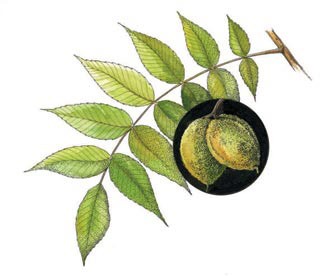
Healthy butternut trees are now so rare that, before the image of this tree in its full glory fades, let’s bring the butternut tree of 40 years ago to mind. Back then it was a robust member of the tree community, found on rich, moist loams, on limey, rocky soils, and in the dooryards of a high percentage of old farms. In short, butternut had its pick of the best sites. Planted by both people and squirrels, it was a distinctive and lovely tree in all these settings.
Butternuts do not do at all well growing in shade. They only have leaves at the sunny tips of their branches; the rest of the tree is too shady. The bare interior and the thin, high canopy give the tree a light, airy appearance. Leafing out late and dropping their leaves early, they provide shade only when needed, a beautiful dappled shade – a perfect yard tree for this climate.
Butternut grows rapidly, to a moderate height of around 60 feet. Typically, a tree lives for only about 75 years. Its branches spread widely when grown in the open. In the forest, butternuts are sometimes tall and narrow crowned, just like other trees. But healthy butternuts release a toxic chemical compound into the soil called juglone, which can deter competing trees. In such cases, even in the forest, a butternut will spread its branches as widely as it wants, so wide, in fact, that its thin shade permits a circular grassy patch to grow in the middle of the woods. In autumn, you might find one of these grassy patches by following the sound of red squirrel gibberish.
The twigs are stout, built to hold unusually large compound leaves that have as many as 17 leaflets. If you come upon a fallen branch, a leaf scar provides a useful feature for winter tree ID: it resembles a monkey’s face, complete with furry eyebrows. In winter, the next year’s terminal buds are large and fuzzy; the lateral ones are smaller and rounder. The ashy gray bark on older trees is distinctive in winter, too. It has a braided look, with the braids looking as though they have been ironed flat.
Male and female flowers appear on the same tree in early summer. The male flowers are catkins, borne in the axils of the previous year’s growth. Female flowers are on a short spike near the end of the twigs. Soon, nutlets can be seen in small bunches. When they mature, the nuts become hard and dense and are enclosed in a sticky husk. Bunches of nuts often remain on the tree after the leaves have dropped in autumn.
The nuts were an important food for Native Americans; archaeologists have often found charred butternut shells in prehistoric hearths. Colonists made pickles from the soft, unripe, green nuts and considered them a delicious accompaniment to meat. Natives taught early colonists how to make brown and yellow dye from the husks.
The sapwood of butternut is light while the heartwood is a deep brown. Sometimes furniture makers and cabinet makers use just the heartwood; other times the contrast of the two colors can be striking. Although the wood is softer than black walnut, both are easily worked, never crack or warp, and take finishes well. A satiny radiance emanates from butternut wood, and it is a favorite of woodcarvers. Butternut grows farther east and north than black walnut and is sometimes called white walnut because of its light-colored sapwood.
Two deficiencies should be noted. First, butternut’s autumn color is drab, with more brown than yellow in its shriveled leaves. Second, as firewood, it has about as many BTUs per cord as white pine or aspen and, unlike those species, is reluctant to burn.
But now butternut canker has swept across the tree’s range, infecting nearly every specimen. It’s a true horror story, and it’s hard not to feel as morose as the trees look. Butternut trees don’t die willingly: hopeful-looking tufts of leaves burst from the trunk after the branches have expired; later the leafless, gaunt, peeling, rot-resistant skeletons stand accusingly for years.
Since no one knows where this disease came from or how it arrived here, it’s hard to know how it could have been prevented. Still, this scourge is a reminder that we need to take good care of trees whenever we can.


Discussion *